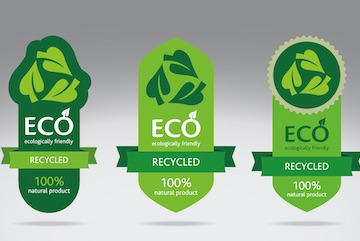There is a growing concern for the environment. Conserving resources is becoming more popular. Have you considered how your business can help the environment and make money whilst doing it?
First, evaluate your products. If you have a choice of suppliers, choose the one that uses less plastic (assuming the cost is equivalent) and explain why. Consider cutting down on single-use or limited-life products and concentrate on items that will last longer or are easily recycled. That is not a gimmick. Consumers will likely move in this direction and will seek items that last longer. The age of planned obsolescence is over.
The age of planned obsolescence is over.
Packaging
Some suppliers offer a choice in packaging. When I started trading 20 years ago, products were designed for physical shops. They tended to be encased in plastic and hung from hooks or placed on a shelf.
With the rise in ecommerce, some suppliers now offer warehouse-friendly packaging where items are stackable. This helps maximize storage space and can also reduce fulfillment costs because the items are easier to box up. See if your suppliers have considered this.
Another obvious area is in postage packaging. Many businesses use standard-sized boxes and void fill to make up for the size of the item and the size of the box. I try not to use void fill as it is a waste. I prefer to cut the box down to size.
Recently however I have started using recycled boxes. Every week I go to a local shoe shop and get a couple of sacks of boxes. Many customers leave the boxes behind after buying the shoes. Shoe boxes work well for most items I sell. They are free, and I am reducing waste.
Likewise, I try to reuse delivery boxes, including from other area shops. This, again, reduces waste and lowers my packaging expense.
There are downsides, however, to reusing boxes. They are not standard sizes, so it can take longer to find a suitable box and thus pack an order. Also, some customers complain!
When I first started using shoe boxes, a small percentage of my U.S. customers complained. One U.K. customer phoned, confused, demanding the shoes with the box. Eventually, I started including a paragraph at the bottom of each receipt explaining our policy of recycling, reducing waste, and doing what we can to help the environment. This seems to be working.
Recently Amazon has started using plastic bags instead of boxes. There is a growing backlash to this. Independent merchants can take advantage of it by promoting our use of recycled boxes, or, if necessary, recycled cardboard.
Volume vs. Price?
Selling environmentally friendly products, however, could mean a change in business strategy. Better designed, longer-lasting products will inevitably mean lower sales volume. To survive, merchants will need better margins and higher prices.
The food industry has experienced a similar issue with consumers who seek organic, healthy food. Grocers have increased their marketing of such products and succeeded in persuading customers to pay more — providing higher margins and better profits.
Sooner or later all retail consumers will look for quality products that last longer. As merchants, we must follow this trend by changing our product lines, marketing, and indeed our entire ethos. We’ll make money by selling fewer items at a higher profit.
Retail has changed in the past few years. Businesses are moving away from physical shops and migrating to the internet and ecommerce. Whilst this trend will continue, it is approaching saturation.
The large box shifters such as Amazon will likely continue to concentrate on high volumes, low margins, and squeezing costs. But the demand for low-volume, quality, and environmentally-friendly goods is growing. It is likely the biggest growth market. So join in.







